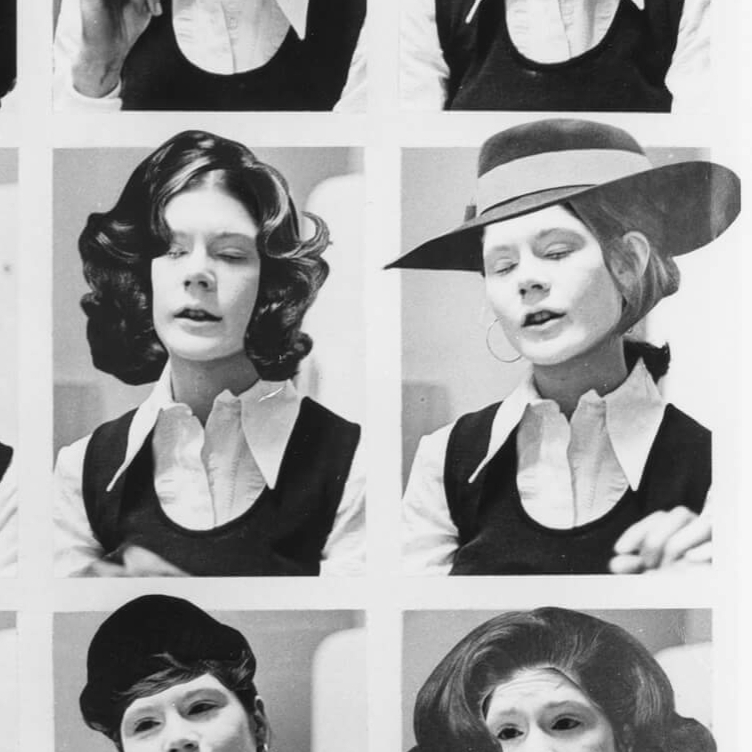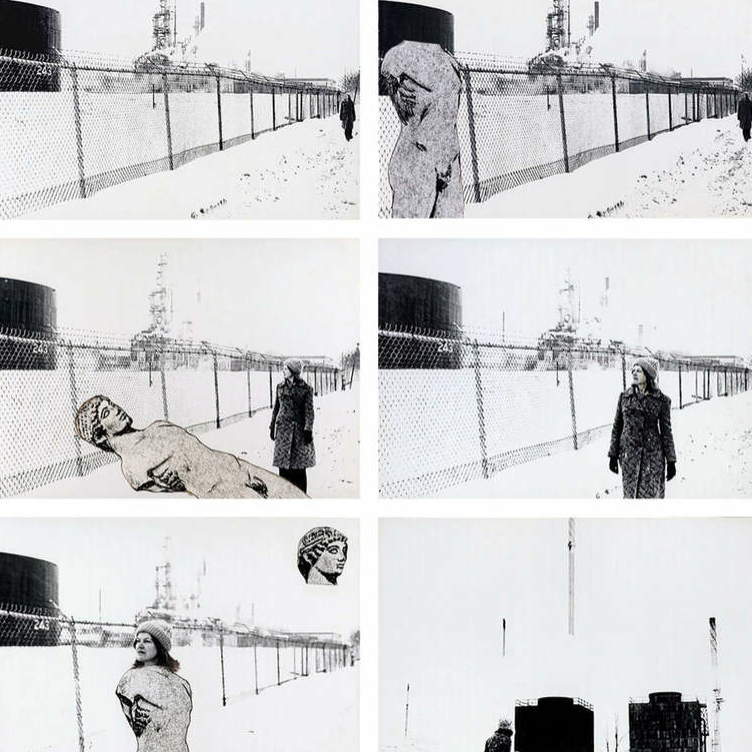Mary Pratt (1935–2018) was a Realist painter whose subject was the immediate world around her, most often the objects and people within her homes in Salmonier and St. John’s, Newfoundland. From the mid-1970s—when the second wave of the North American feminist movement was reaching the height of its popularity and influence—Pratt was held up as an example. However, she was ambivalent about this positioning. In 1975 Pratt said, “I have quite strong feelings about the women’s movement, without really being part of it.” That same year, for her first major group exhibition, Some Canadian Women Artists at the National Gallery of Canada, Ottawa, Pratt provided an artist statement that seemed to deflect a political reading of her work: “I simply copy this superficial coating because I like the look of it.”

Oil on Masonite, 50.8 x 71.1 cm
Owens Art Gallery, Mount Allison University, Sackville
Perhaps Pratt was being coy, for even though she never officially admitted to social commentary, one cannot look at her work without seeing a focused and thoughtful interrogation of the domestic: from the quotidian hurly-burly of meals, laundry, cleaning, and child care, to the myriad elements that come with the gendered social constructs of family and the home. Nonetheless, Pratt felt the need to downplay the intellectual content of her work.
Yet the “superficial coating” of Pratt’s world has unmistakable depth. Her insistence on and struggle with taking on multiple roles of wife, mother, homemaker, and artist speaks to something important for her generation of women. Many women wanted to expand the roles available to them, and Pratt echoed this sentiment when she told a newspaper, remembering her feelings from decades earlier, “I intend to have children and to have food on the table, and I intend to do the ironing, but I will have time to paint.”

Oil on Masonite, 42 x 57.2 cm
Museum London
In 1976, writing for the catalogue of her first solo exhibition in Toronto, Robert Fulford called Mary Pratt “the visual poet of the kitchen.” Tom Smart later deemed this phrase “derogatory, patronizing, and simplistic,” despite acknowledging that it provided a convenient hook on which curators and critics could hang their interpretations, and actually enhanced Pratt’s growing reputation. It was nevertheless unfortunate, suggesting that Pratt’s concerns were not cerebral or consequential.

Oil on linen, 91.4 x 137.2 cm
Beaverbrook Art Gallery, Fredericton
In actual fact, Pratt was not a born housekeeper. “I came to domesticity with great difficulty,” she told one interviewer. “My mother did not instruct in the art of the domestic; she was a very half-hearted housekeeper.” Moving to Salmonier, and having four small children and a husband to care for, Pratt had little choice but to buckle down and master this “art of the domestic.” It was what was expected of her, and also what she expected of herself. But her “difficulty” with such work might have added to her sharp, detached perspective in such paintings as Salmon on Saran, 1974, and Supper Table, 1969.
Increasingly, Mary Pratt’s work is seen as being influential for its subject matter. As Mireille Eagan writes, “Pratt’s art is regularly positioned with the feminist movement which operated under the umbrella of politics rather than aesthetics.” Initially, in the 1970s, Pratt was seen as a woman succeeding in a man’s world, overcoming the challenges of having a career and raising a family. Paradoxically, her subject matter was seen as an exemplar of the oppression of women: the housework, the laundry, the unbalanced sharing of the domestic burden.

Oil on Masonite, 45.7 x 76.2 cm
Collection of Angus and Jean Bruneau
But Pratt’s kitchen scenes become sites for resistance in more recent criticism. Even if Pratt’s politics were largely private, or understated, she was not shy in underlining that the balancing act of being an artist and making a home was difficult, and a cause of strain in her marriage. “There was a terrible war going on in my head,” she told Sandra Gwyn. As Catharine Mastin writes, “[Pratt] would make the family home and kitchen in Salmonier no silent place of oppression but an active location from which to establish a voice of sexual difference.”
This Essay is excerpted from Mary Pratt: Life & Work by Ray Cronin.
 Karen Tam’s Autumn Tigers
Bridging Past and Present: Invisible Made Visible
By Imogene L. Lim, PhD
Karen Tam’s Autumn Tigers
Bridging Past and Present: Invisible Made Visible
By Imogene L. Lim, PhD
 The Frontier Portraits of C.D. Hoy
A Chinese Canadian Photographer’s Tribute to His Community
By Faith Moosang
The Frontier Portraits of C.D. Hoy
A Chinese Canadian Photographer’s Tribute to His Community
By Faith Moosang
 Interrogating Identity
Suzy Lake explores the role of photography in shaping how we understand and see ourselves
By Erin Silver
Interrogating Identity
Suzy Lake explores the role of photography in shaping how we understand and see ourselves
By Erin Silver
 An Emboldened Artist
How Oviloo Tunnillie achieved rare international acclaim as an Inuit female sculptor
By Darlene Coward Wight
An Emboldened Artist
How Oviloo Tunnillie achieved rare international acclaim as an Inuit female sculptor
By Darlene Coward Wight
 Painting the Cultural Mosaic
William Kurelek traversed the country in a quest to capture its diverse inhabitants
By Andrew Kear
Painting the Cultural Mosaic
William Kurelek traversed the country in a quest to capture its diverse inhabitants
By Andrew Kear
 A New Vision of the North
Annie Pootoogook’s art offers unprecedented insights into the contemporary Arctic
By Nancy G. Campbell
A New Vision of the North
Annie Pootoogook’s art offers unprecedented insights into the contemporary Arctic
By Nancy G. Campbell
 Meetings of Minds
Sorel Etrog found new ideas in collaborative work
By Alma Mikulinsky
Meetings of Minds
Sorel Etrog found new ideas in collaborative work
By Alma Mikulinsky
 Introducing Miss Chief
An excerpt from the ACI’s book “Revision and Resistance”
By Shirley Madill
Introducing Miss Chief
An excerpt from the ACI’s book “Revision and Resistance”
By Shirley Madill
 A Practice of Recovery
An excerpt from the ACI’s book “Revision and Resistance”
By Sasha Suda
A Practice of Recovery
An excerpt from the ACI’s book “Revision and Resistance”
By Sasha Suda
 Decolonizing History Painting
An excerpt from the ACI’s book “Revision and Resistance”
By Ruth B. Phillips and Mark Salber Phillips
Decolonizing History Painting
An excerpt from the ACI’s book “Revision and Resistance”
By Ruth B. Phillips and Mark Salber Phillips
 A Vision for the Future
An excerpt from the ACI’s book “Revision and Resistance”
By Nick Estes
A Vision for the Future
An excerpt from the ACI’s book “Revision and Resistance”
By Nick Estes
 Inside Kent Monkman’s Studio
An excerpt from the ACI’s book “Revision and Resistance”
By Jami C. Powell
Inside Kent Monkman’s Studio
An excerpt from the ACI’s book “Revision and Resistance”
By Jami C. Powell
 The Rule of Chance
Jean Paul Riopelle’s break with Automatism
By François-Marc Gagnon
The Rule of Chance
Jean Paul Riopelle’s break with Automatism
By François-Marc Gagnon
 From Taos to New York
Agnes Martin and the currents of American Art
By Christopher Régimbal
From Taos to New York
Agnes Martin and the currents of American Art
By Christopher Régimbal
 An Artist Blooms
Mary Hiester Reid’s floral aesthetics
By Andrea Terry
An Artist Blooms
Mary Hiester Reid’s floral aesthetics
By Andrea Terry
 The Patriotic Painter
Greg Curnoe’s Canada
By Judith Rodger
The Patriotic Painter
Greg Curnoe’s Canada
By Judith Rodger
 Walking, Stacking, Dancing
Françoise Sullivan’s conceptual 1970s
By Annie Gérin
Walking, Stacking, Dancing
Françoise Sullivan’s conceptual 1970s
By Annie Gérin
 The Extraordinary North
Tom Thomson’s diary of landscape
By David P. Silcox
The Extraordinary North
Tom Thomson’s diary of landscape
By David P. Silcox
 A Champion of Abstraction
Jock Macdonald sought a new expression in art
By Joyce Zemans
A Champion of Abstraction
Jock Macdonald sought a new expression in art
By Joyce Zemans
 Defiant Spirit
Quebecois artist Ozias Leduc drew on Europe but created a Canadian ideal
By Laurier Lacroix
Defiant Spirit
Quebecois artist Ozias Leduc drew on Europe but created a Canadian ideal
By Laurier Lacroix